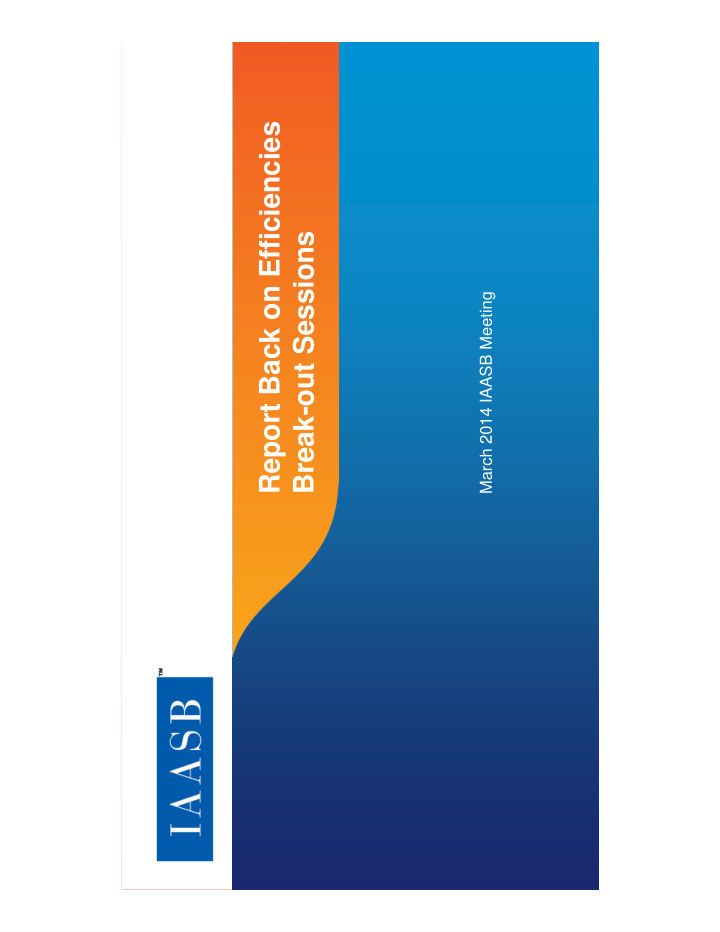



Page 1 Report Back on Efficiencies Break-out Sessions March 2014 IAASB Meeting
Overview • Break-out sessions focused on three key themes – Enhancing efficiency and reducing the burden on Board members – Informing Board members on key issues in a timely manner – Effectively utilizing project task forces • Board participants engaged actively in break-out discussions; many frank observations and useful suggestions Page 2
Purpose of This Session • Report back on the main messages and various feedback received – Are there additional preliminary views that should be further captured in Staff’s feedback summary? – Are there initial views on areas that should be explored as a matter of priority? • Recommendations and way forward, in consultation with Steering Committee, for June 2014 IAASB meeting Page 3
Key Messages • Board faces many important and significant demands – Limitations on volunteer and staff resources, so efforts have to be optimized • Efficiency improvement opportunities exist! – Welcome efforts to explore and capitalize on opportunities Indeed, doing so is essential – A strong commitment to taking action, recognizing discipline will be important to achieving benefits Page 4
Key Messages (cont.) • The quality of Board material, and the way in which it is structured, play a critical role in helping focus debates • Well-researched and clearly-scoped projects benefit work effort over the life of a project • Take advantage of opportunities to further inform Board or progress debates • Task forces leadership and adequate staff support are essential Page 5
Key Messages (cont.) • Merits of more flexible approaches to critical work, with the Board and within task forces – Trade-offs exist in terms of timeliness of material and further refinement • Clarity needed about level of Board involvement in the process for material other than standards • A continuous process - this includes assessing “lessons learned” and considering benefits of approaches of others • Highly talented group of technical advisors! Page 6
Feedback and Suggestions • Quality and orientation of Board materials – Structure should focus on clearly articulating questions of principle and strategy/direction Will further assist Board in giving clear direction to task forces, particularly after lengthy discussion – Other enhancements may further assist Board processes E.g., use of “decision summaries,” carried forward within agenda material throughout life of project? May minimize re-deliberation of previous decisions o Page 7
Feedback and Suggestions (cont.) • Clearly articulate the public interest issues to be addressed and educate the Board as necessary when scoping a project – Critically challenge merits of a project • Continue to progress debates timely – Greater use of Board teleconferences; pre-scheduled? • Further inform Board deliberations through, e.g., feedback from outreach, CAG minutes, use of discussion papers, presentations by subject-matter experts, research at the national level, etc. Page 8
Feedback and Suggestions (cont.) • Task Forces – Selection criteria for chairmanship Recognizing time commitment and unique balance of skills – Guidance document for TF chairs, members and staff re: roles and responsibilities E.g., In relation to acclimating new members; drafting considerations; finalizing materials with staff in light of TF input – Challenge optimal composition and size of TFs, and need for physical meetings – More emphasis needed on review by senior Staff Page 9
Feedback and Suggestions (cont.) • Consider opportunities to leverage strengths and interests of Board members, TAs, NSS and others in – Working Group participation/other exploratory activities – Leading outreach/other initiatives at the constituent level • Consider “negative clearance” process for non-Standards documents and challenge need for exposure; clarity of expectations/discipline regarding fatal flaw reviews, e.g., discussion papers, EMs, Basis for Conclusions, Staff documents • Post-mortem reviews and benchmarking exercises? Page 10
Other Suggestions Raised • Increased use of “straw polls” to confirm direction and ensure dissenting views are known earlier • Greater use of soliciting editorial comments in advance of the meeting; thereby less focus on detailed drafting during meetings – Consider smaller group “education sessions” in advance of the public meeting • Need sufficient “reserved for reading” time and task force time, in particular when standards are to be approved Page 11
Other Suggestions Raised (cont.) • Overall consideration of the ideal number of topics for a Board meeting agenda to allow for appropriate advance consultation • Involve subject-matter experts appropriately (e.g., project advisory panels, task forces, correspondent members) • Greater use of technology Page 12
Possible Areas for “Quick Wins”/ Early Initiatives • Minutes to focus on “decision summary”; summary to carry forward in project papers – Transcripts for reference to details of discussion being explored • Improved structure and focus of Board papers • Guide for TF Chairs and staff • Pre-scheduled dates for provisional Board teleconferences • Board process for non-authoritative documents Page 13
www.iaasb.org
Recommend
More recommend